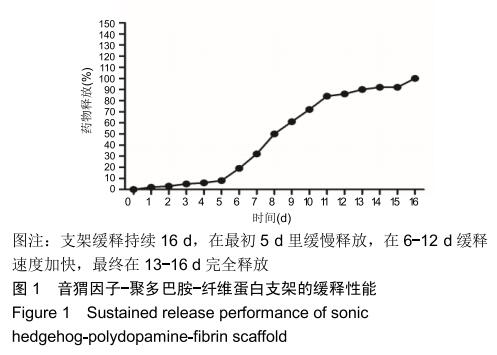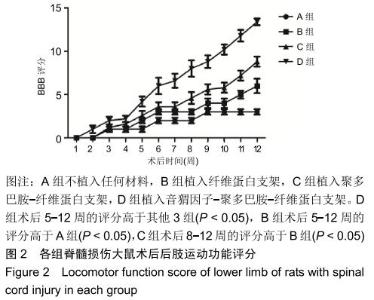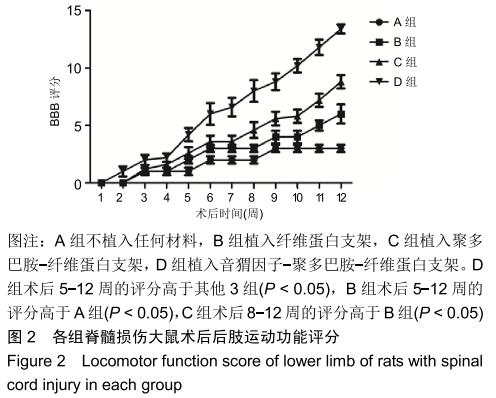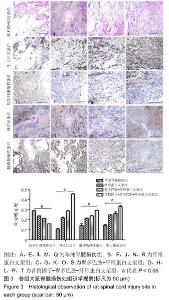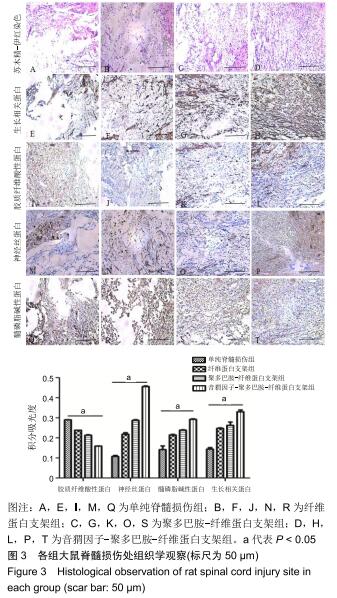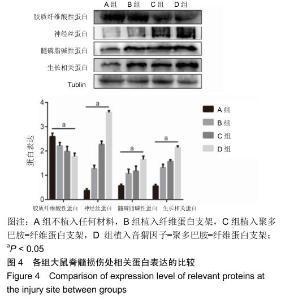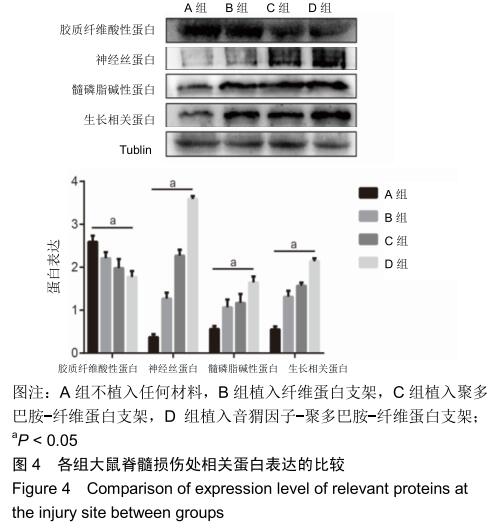Chinese Journal of Tissue Engineering Research ›› 2020, Vol. 24 ›› Issue (28): 4567-4572.doi: 10.3969/j.issn.2095-4344.2303
Previous Articles Next Articles
Sonic hedgehog-polydopamine-fibrin scaffold promotes recovery of spinal cord injury in rats
Cao Sucheng1, 2, Xu Xiaofeng1, 2, Chen Qi1, 2, Lu Hao1, 2, Wang Zhe2, Zhang Rui1, 2, Wang Yao2, Zhang Zhijian2, Yang Wenjing2
1Department of Orthopedics, Affiliated Hospital of Jiangsu University, Zhenjiang 212000, Jiangsu Province, China; 2School of Medicine, Jiangsu University, Zhenjiang 212000, Jiangsu Province, China
-
Received:2019-11-16Revised:2019-11-20Accepted:2019-12-26Online:2020-10-08Published:2020-09-01 -
Contact:Xu Xiaofeng, Chief physician, Department of Orthopedics,Affiliated Hospital of Jiangsu University, Zhenjiang 212000, Jiangsu Province, China; School of Medicine, Jiangsu University, Zhenjiang 212000, Jiangsu Province, China -
About author:Cao Sucheng, Master candidate, Department of Orthopedics, Affiliated Hospital of Jiangsu University, Zhenjiang 212000, Jiangsu Province, China; School of Medicine, Jiangsu University, Zhenjiang 212000, Jiangsu Province, China -
Supported by:the National Natural Science Foundation of China, No. 51403086 ; the Natural Science Foundation of Jiangsu Province, No. BK20140544 ; the Senior Talent Start-Up Foundation of Jiangsu University, No. 13JDG089
CLC Number:
Cite this article
Cao Sucheng, Xu Xiaofeng, Chen Qi, Lu Hao, Wang Zhe, Zhang Rui, Wang Yao, Zhang Zhijian, Yang Wenjing.
Sonic hedgehog-polydopamine-fibrin scaffold promotes recovery of spinal cord injury in rats [J]. Chinese Journal of Tissue Engineering Research, 2020, 24(28): 4567-4572.
share this article
|
[1] COUILLARD-DESPRES S, BIELER L, VOGL M. Pathophysiology of Traumatic Spinal Cord Injury. //Weidner N., Rupp R., Tansey K. (eds) Neurological Aspects of Spinal Cord Injury. Springer, Cham, 2017.
[2] SCHWAB ME, BARTHOLDI D. Degeneration and regeneration of axons in the lesioned spinal cord. Physiol Rev.1996;76(2): 319-370.
[3] ROWLAND JW, HAWRYLUK GW, KWON B, et al. Current status of acute spinal cord injury pathophysiology and emerging therapies: promise on the horizon.Neurosurg Focus. 2008; 25(5):E2.
[4] ORR MB, GENSEL JC. Interactions of primary insult biomechanics and secondary cascades in spinal cord injury: implications for therapy. Neural Regen Res.2017;12(10): 1618-1619.
[5] ROUANET C, REGES D, ROCHA E, et al. Traumatic spinal cord injury: current concepts and treatment update. Arq Neuropsiquiatr. 2017;75(6):387-393.
[6] SABELSTRÖM H, STENUDD M, FRISÉN J. Neural stem cells in the adult spinal cord.Exp Neurol. 2014;260:44-49.
[7] TUINSTRA HM, AVILES MO, SHIN S, et al. Multifunctional, multichannel bridges that deliver neurotrophin encoding lentivirus for regeneration following spinal cord injury.Biomaterials. 2012; 33(5):1618-1626.
[8] ASSINCK P, DUNCAN GJ, HILTON BJ, et al. Cell transplantation therapy for spinal cord injury.Nat Neurosci.2017;20(05):637-647.
[9] HAGGERTY AE, MALDONADO-LASUNCIÓN I, OUDEGA M. Biomaterials for revascularization and immunomodulation after spinal cord injury. Biomed Mater. 2018;13(4):044105.
[10] LIU S, XIE YY, WANG B. Role and prospects of regenerative biomaterials in the repair of spinal cord injury. Neural Regen Res. 2019;14(8):1352-1363.
[11] CHEDLY J, SOARES S, MONTEMBAULT A, et al. Physical chitosan microhydrogels as scaffolds for spinal cord injury restoration and axon regeneration.Biomaterials.2017;138:91-107.
[12] IWAYA K, MIZOI K, TESSLER A, et al. Neurotrophic agents in fibrin glue mediate adult dorsal root regeneration into spinal cord. Neurosurgery. 1999;44(3):589-596.
[13] KALSI P, THOM M, CHOI D. Histological effects of fibrin glue and synthetic tissue glues on the spinal cord: are they safe to use?. Br J Neurosurg. 2017;31(6):695-700.
[14] LUZZI S, CROVACE AM, LACITIGNOLA L, et al. Engraftment, neuroglial transdifferentiation and behavioral recovery after complete spinal cord transection in rats [published correction appears in Surg Neurol Int. 2018;9:77.
[15] LUND J, TOU S, DOLEMAN B, et al. Fibrin glue for pilonidal sinus disease. Cochrane Database Syst Rev. 2017;1(1):CD011923.
[16] GIACOMINI A, STAGNI F, TRAZZI S, et al. Inhibition of APP gamma-secretase restores Sonic Hedgehog signaling and neurogenesis in the Ts65Dn mouse model of Down syndrome. Neurobiol Dis.2015;82:385-396.
[17] ANTONELLI F, CASCIATI A, PAZZAGLIA S. Sonic hedgehog signaling controls dentate gyrus patterning and adult neurogenesis in the hippocampus. Neural Regen Res. 2019; 14(1):59-61.
[18] 李之朋,徐文彪,时君友.生物质仿贻贝粘附材料的研究进展[J].粘接, 2018(7):55-60.
[19] HOU S, CARSON DM, WU D, et al. Dopamine is produced in the rat spinal cord and regulates micturition reflex after spinal cord injury.Exp Neurol.2016;285(Pt B):136-146.
[20] JIANG W, LI M, HE F, et al. Targeting the NLRP3 inflammasome to attenuate spinal cord injury in mice. J Neuroinflammation. 2017;14(1):207. [21] YUE JK, TSOLINAS RE, BURKE JF, et al. Vasopressor support in managing acute spinal cord injury: current knowledge. J Neurosurg Sci. 2019;63(3):308-317.
[22] KO MY, JANG EY, LEE JY, et al. The role of ventral tegmental area gamma-aminobutyric acid in chronic neuropathic pain after spinal cord injury in rats. J Neurotrauma.2018; 35(15):1755-1764.
[23] RYU JH, MESSERSMITH PB, LEE H. Polydopamine Surface Chemistry: A Decade of Discovery. ACS Appl Mater Interfaces. 2018;10(9):7523-7540.
[24] PALLADINO P, BETTAZZI F, SCARANO S. Polydopamine: surface coating, molecular imprinting, and electrochemistry- successful applications and future perspectives in (bio)analysis. Anal Bioanal Chem. 2019;411(19):4327-4338.
[25] YU B, WANG DA, YE Q, et al. Robust polydopamine nano/microcapsules and their loading and release behavior. Chem Commun (Camb). 2009;(44):6789-6791.
[26] 杨文静,沈元昊,杨开元,等.定向多通道纤维蛋白支架对EMSCs迁移分化的影响[J].神经解剖学杂志,2018,34(6):658-664.
[27] 崔学文,张竞新,许艺荠,等.SHH缓释纤维蛋白支架移植促大鼠脊髓损伤的修复[J].神经解剖学杂志,2017,33(2):131-137.
[28] JUNG SY, SEO TB, KIM DY. Treadmill exercise facilitates recovery of locomotor function through axonal regeneration following spinal cord injury in rats. J Exerc Rehabil. 2016;12(4): 284-292.
[29] 徐向东,卢向红,施勇,等.纤维蛋白胶顺铂凝胶化疗的缓释特性[J].中华医学杂志,2011,91(18):1246-1249.
[30] LIU Q, YU B, YE W, et al. Highly selective uptake and release of charged molecules by pH-responsive polydopamine microcapsules. Macromol Biosci. 2011;11(9):1227-1234.
[31] YANG K, LEE JS, KIM J, et al. Polydopamine-mediated surface modification of scaffold materials for human neural stem cell engineering [published correction appears in Biomaterials. 2012 Nov;33(32):8186-7]. Biomaterials. 2012;33(29):6952-6964.
[32] BARNABÉ-HEIDER F, FRISÉN J. Stem cells for spinal cord repair. Cell Stem Cell. 2008;3(1):16-24.
[33] STEWARD O, SHARP KG, YEE KM, et al. Characterization of ectopic colonies that form in widespread areas of the nervous system with neural stem cell transplants into the site of a severe spinal cord injury. J Neurosci. 2014;34(42):14013-14021.
[34] WANG T, LI B, YUAN X, et al. MiR-20a Plays a Key Regulatory Role in the Repair of Spinal Cord Dorsal Column Lesion via PDZ-RhoGEF/RhoA/GAP43 Axis in Rat. Cell Mol Neurobiol. 2019;39(1):87-98.
[35] UGBODE CI, SMITH I, WHALLEY BJ, et al. Sonic hedgehog signalling mediates astrocyte crosstalk with neurons to confer neuroprotection. J Neurochem. 2017;142(3):429-443.
[36] SAADE M, GONZALEZ-GOBARTT E, ESCALONA R, et al. Shh-mediated centrosomal recruitment of PKA promotes symmetric proliferative neuroepithelial cell division [published online ahead of print, 2017 Apr 27]. Nat Cell Biol. 2017;19(5): 493-503.
[37] FARRENY MA, AGIUS E, BEL-VIALAR S, et al. FGF signaling controls Shh-dependent oligodendroglial fate specification in the ventral spinal cord. Neural Dev. 2018;13(1):3.
[38] ZHENG B, YE L, ZHOU Y, et al. Epidermal growth factor attenuates blood-spinal cord barrier disruption via PI3K/Akt/Rac1 pathway after acute spinal cord injury. J Cell Mol Med. 2016;20(6): 1062-1075.
[39] XIA T, HUANG B, NI S, et al. The combination of db-cAMP and ChABC with poly(propylene carbonate) microfibers promote axonal regenerative sprouting and functional recovery after spinal cord hemisection injury. Biomed Pharmacother. 2017;86:354-362.
[40] GUO WL, QI ZP, YU L, et al. Melatonin combined with chondroitin sulfate ABC promotes nerve regeneration after root-avulsion brachial plexus injury. Neural Regen Res. 2019;14(2):328-338. |
| [1] | Min Youjiang, Yao Haihua, Sun Jie, Zhou Xuan, Yu Hang, Sun Qianpu, Hong Ensi. Effect of “three-tong acupuncture” on brain function of patients with spinal cord injury based on magnetic resonance technology [J]. Chinese Journal of Tissue Engineering Research, 2021, 25(在线): 1-8. |
| [2] | Zhang Chong, Liu Zhiang, Yao Shuaihui, Gao Junsheng, Jiang Yan, Zhang Lu. Safety and effectiveness of topical application of tranexamic acid to reduce drainage of elderly femoral neck fractures after total hip arthroplasty [J]. Chinese Journal of Tissue Engineering Research, 2021, 25(9): 1381-1386. |
| [3] | Wang Haiying, Lü Bing, Li Hui, Wang Shunyi. Posterior lumbar interbody fusion for degenerative lumbar spondylolisthesis: prediction of functional prognosis of patients based on spinopelvic parameters [J]. Chinese Journal of Tissue Engineering Research, 2021, 25(9): 1393-1397. |
| [4] | Chen Jinping, Li Kui, Chen Qian, Guo Haoran, Zhang Yingbo, Wei Peng. Meta-analysis of the efficacy and safety of tranexamic acid in open spinal surgery [J]. Chinese Journal of Tissue Engineering Research, 2021, 25(9): 1458-1464. |
| [5] | Shu Wenbo, Chen Mengchi, Li Hua, Huang Liqian, Huang Binbin, Zhang Wenhai, Wu Yachen, Wang Zefeng, Li Qiaoli, Liu Peng. Correlation between body fat distribution and characteristics of daily physical activity in college students [J]. Chinese Journal of Tissue Engineering Research, 2021, 25(8): 1277-1283. |
| [6] | Ji Zhixiang, Lan Changgong. Polymorphism of urate transporter in gout and its correlation with gout treatment [J]. Chinese Journal of Tissue Engineering Research, 2021, 25(8): 1290-1298. |
| [7] | Jiang Hongying, Zhu Liang, Yu Xi, Huang Jing, Xiang Xiaona, Lan Zhengyan, He Hongchen. Effect of platelet-rich plasma on pressure ulcers after spinal cord injury [J]. Chinese Journal of Tissue Engineering Research, 2021, 25(8): 1149-1153. |
| [8] | Wu Xun, Meng Juanhong, Zhang Jianyun, Wang Liang. Concentrated growth factors in the repair of a full-thickness condylar cartilage defect in a rabbit [J]. Chinese Journal of Tissue Engineering Research, 2021, 25(8): 1166-1171. |
| [9] | Shen Jinbo, Zhang Lin. Micro-injury of the Achilles tendon caused by acute exhaustive exercise in rats: ultrastructural changes and mechanism [J]. Chinese Journal of Tissue Engineering Research, 2021, 25(8): 1190-1195. |
| [10] | Zeng Zhen, Hu Jingwei, Li Xuan, Tang Linmei, Huang Zhiqiang, Li Mingxing. Quantitative analysis of renal blood flow perfusion using contrast-enhanced ultrasound in rats with hemorrhagic shock during resuscitation [J]. Chinese Journal of Tissue Engineering Research, 2021, 25(8): 1201-1206. |
| [11] | Tang Hui, Yao Zhihao, Luo Daowen, Peng Shuanglin, Yang Shuanglin, Wang Lang, Xiao Jingang. High fat and high sugar diet combined with streptozotocin to establish a rat model of type 2 diabetic osteoporosis [J]. Chinese Journal of Tissue Engineering Research, 2021, 25(8): 1207-1211. |
| [12] | Chai Le, Lü Jianlan, Hu Jintao, Hu Huahui, Xu Qingjun, Yu Jinwei, Quan Renfu. Signal pathway variation after induction of inflammatory response in rats with acute spinal cord injury [J]. Chinese Journal of Tissue Engineering Research, 2021, 25(8): 1218-1223. |
| [13] | Liu Xiangxiang, Huang Yunmei, Chen Wenlie, Lin Ruhui, Lu Xiaodong, Li Zuanfang, Xu Yaye, Huang Meiya, Li Xihai. Ultrastructural changes of the white zone cells of the meniscus in a rat model of early osteoarthritis [J]. Chinese Journal of Tissue Engineering Research, 2021, 25(8): 1237-1242. |
| [14] | Liu Cong, Liu Su. Molecular mechanism of miR-17-5p regulation of hypoxia inducible factor-1α mediated adipocyte differentiation and angiogenesis [J]. Chinese Journal of Tissue Engineering Research, 2021, 25(7): 1069-1074. |
| [15] | Wang Zhengdong, Huang Na, Chen Jingxian, Zheng Zuobing, Hu Xinyu, Li Mei, Su Xiao, Su Xuesen, Yan Nan. Inhibitory effects of sodium butyrate on microglial activation and expression of inflammatory factors induced by fluorosis [J]. Chinese Journal of Tissue Engineering Research, 2021, 25(7): 1075-1080. |
| Viewed | ||||||
|
Full text |
|
|||||
|
Abstract |
|
|||||

